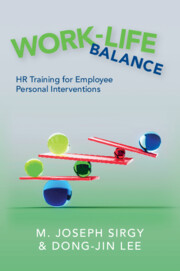Book contents
- Work-Life Balance
- Work-Life Balance
- Copyright page
- Contents
- Figures
- Tables
- Part I Making the Case for Work-Life Balance
- Chapter 1 Introduction
- Chapter 2 Why is Work-Life Balance Important?
- Chapter 3 How Does Work-Life Balance Contribute to Life Satisfaction?
- Part II Behavior-Based Personal Interventions of Work-Life Balance
- Part III Cognition-Based Personal Interventions of Work-Life Balance
- Part IV Epilogue
- Index
- References
Chapter 2 - Why is Work-Life Balance Important?
from Part I - Making the Case for Work-Life Balance
Published online by Cambridge University Press: 19 January 2023
- Work-Life Balance
- Work-Life Balance
- Copyright page
- Contents
- Figures
- Tables
- Part I Making the Case for Work-Life Balance
- Chapter 1 Introduction
- Chapter 2 Why is Work-Life Balance Important?
- Chapter 3 How Does Work-Life Balance Contribute to Life Satisfaction?
- Part II Behavior-Based Personal Interventions of Work-Life Balance
- Part III Cognition-Based Personal Interventions of Work-Life Balance
- Part IV Epilogue
- Index
- References
Summary
We make the case in this chapter that work-life balance is an important topic because research has shown that work-life balance influences a host of organizational outcomes (e.g., organizational identification, loyalty, and commitment; turnover, job performance, employee morale, and organizational citizenship) and personal outcomes (employee stress, employee burnout, employee wellbeing, satisfaction with life overall, personal happiness, eudaimonia, satisfaction with family life, satisfaction with social life, satisfaction with leisure life, satisfaction with spiritual life, satisfaction with financial life, etc.).
Keywords
- Type
- Chapter
- Information
- Work-Life BalanceHR Training for Employee Personal Interventions, pp. 16 - 24Publisher: Cambridge University PressPrint publication year: 2023



